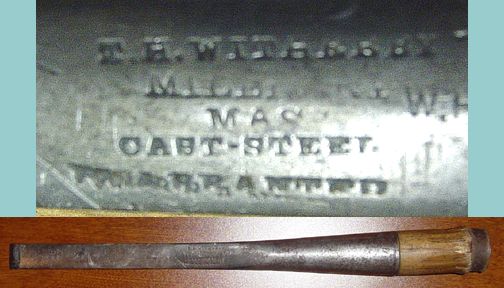
[Under Heavy Construction, January 2008]
T.H. Witherby is somewhat of a mystery man. Chisels marked "T.H. Witherby" are among the most highly sought after chisels among users of old tools and many people associate T.H. Witherby with Winsted, Connecticut and the Winsted Edge Tool Works. But he lived his whole life in Shrewsbury, Millbury, or Worcester, Massachusetts. He was one of the premier edge tool makers of the mid 19th century, known far and wide beyond Millbury, Mass. but had nothing to do with the Winsted Edge Tool Works. Most of the chisels that we find today which are marked "T.H Witherby" were manufactured in Winsted, but the reputation for quality was forged in Millbury.

T.H. (Thomas Heuston) Witherby was born on June 25, 1802 in Shrewsbury, Massachusetts, a town on the eastern border of Worcester in central Massachusetts. He was the second oldest child of six children. (The youngest of the six was Luke Bucklin Witherby, who was the Witherby part of the prominent Worcester manufacturer of woodworking machinery, Witherby, Rugg, and Richardson.) T.H. married Lois Drury on February 22, 1824. Their first child, George Franklin Witherby was born in 1825, followed by Calvin Knowlton (C.K.) Witherby in 1829 (Calvin was named after T.H.'s older brother who died in 1827). Calvin lived with or next door to T.H. until T.H. died and seems to have played a prominent role in the Witherby edge tool business.
In 1832 T.H. was granted patent X7170 (July 17, 1832) for a Coffee-Mill. The patent was lost in the 1836 patent office fire. He was already listed as living Millbury, MA at that time, which borders Worcester and is a very short distance from Shrewsbury.
Both Lois and George died in 1838. T. H. remarried in 1839, to a Mary Forbes. They had a son, Edwin Thomas Witherby, in 1845 and a daughter, Sarah Eliza, in 1848 (she died in 1863). Mary died in 1854.
T.H. Witherby was a Millbury town selectman in 1842 and he was a deacon of the Second Congregational Church of Millbury and is referred to as "Deacon Witherby" in many sources. Another history calls him simply a "manufacturer of edge tools, and prominent in business and public affairs."
He won the Silver Medal for chisels and drawknives at the Fair of the American Institute of the City of New York in 1850. He is listed in a Massachusetts-wide directory as an edge-tool manufacturer in Millbury from 1849-1854 (1849 was the earliest year available to me).
In 1856, Witherby was very successful and well known. But for some reason he decided to sell the business and walk away from it all. My own speculation is that it is partially due to the death of his second wife, Mary, in 1854. But I don't think we will ever know exactly why. One reference states that it was Calvin Witherby who sold the company, so maybe T.H. wasn't running the business himself at that point.
The business was bought out in 1856 by Harrington, Heald & Co., who at the time had been manufacturing wrenches at the Junction Shop in Worcester (the Junction Shop, which rented out manufacturing space, was where the Buck Brothers would soon set up shop in 1857 after leaving the employment of D.R. Barton in Rochester to strike out on their own).
I don't know too much about Heald, but Harrington was William Henry Harrington, who just happened to be married to Lucy Forbes, the younger sister of Mary Forbes, Witherby's second wife. Witherby had sold the company to his brother-in-law. It is interesting to note that there is an 1855 patent for a "socket-handle for chisels" (13,101) by Lovell T. Richardson of Worcester and Wm. H. Harrington is one of the witnesses, so maybe he was already involved with his brother-in-law's chisel business before the 1856 purchase of the company.
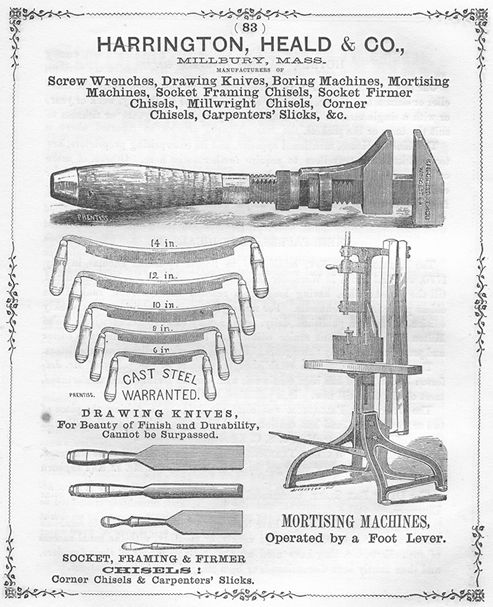
An 1856 ad for Harrington, Heald & Co. lists their products: "Screw Wrenches, Drawing Knives, Boring Machines, Mortising Machines, Socket Framing Chisels, Socket Firmer Chisels, Millwright Chisels, Corner Chisels, Carpenters' Slicks, &c." The wrenches and mortising machines are the original Harrington and Heald products. I have never seen a chisel marked Harrington, Heald, but Sandy Moss (again) recently sold a wrench stamped "Harrington, Heald & Co."

Unfortunately, there was an economic depression in the US starting in 1857, so that by 1858 Harrington, Heald & Co. had failed.
In 1859 they re-emerged as the "T. H. Witherby Tool Company," albeit without Witherby himself. "Witherby" had become a brand name associated with quality (a fact that Harrington and Heald seemed to have figured out the second time around. Makes you wonder if they would have fared better the first time had they kept the Witherby name!).
In 1862 during the Civil War, the Witherby Tool Co. had a government contract to manufacture 25,000 bayonets and ramrods for the Union Army.
In 1868 Harrington & Heald sold the edge tool business to the Winsted Hoe
Company and began the manufacture of woolen goods in their factory instead of
tools. Thus ended the manufacture of Witherby tools in Millbury, MA and begins
the Winsted, CT era of Witherby tools.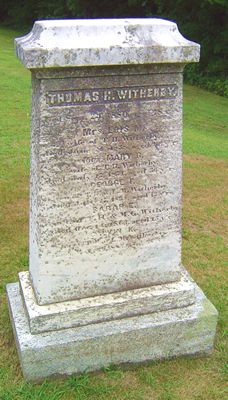
T.H. Witherby had a number of business ventures in the years following 1856, but nothing as successful as his chisel and drawknife business. He appears in the 1859 and 1860 Worcester City Directory selling iron fences with his son C.K. In 1859 he applied along with his brother Luke for a patent in England for "Improvements in rotary steam engines." In 1860 he was granted patent 28,624 (June 5, 1860) for a Rotary Engine, followed by two more in 1870: 101,339 (March 29, 1870) for a Shearing and Punching Machine and 101,338 (March 29, 1870) for a Mower.
In the 1880 census, T.H. was listed as living with his son C.K. in Worcester. T.H. Witherby died September 24, 1880. He is buried in the Millbury Central Cemetery in a lovely spot overlooking the Blackstone River and just a short distance from the graves of R.T. Buck and Charles Buck (the Buck Brothers). The following obituary appeared in the September 28, 1880 Worcester Evening Gazette:
"MILLBURY-The remains of Deacon Thomas H. Witherby, who died in Worcester, were interred in the Central Cemetery on Monday. Deceased was formerly a very prominent business man of this town, and was the founder of the Witherby Edge Tool Company, and for many years the proprietor. He sold out to Harrington & Heald, and it was afterward sold to parties in Winsted, Conn. During his residence here he was a very influential member of the Second Congregational Church of which he was a Deacon, and for several years Superintendent of the Sunday School."
This obituary is the only evidence I have been able to find that the manufacture of Witherby tools moved directly from Millbury, MA to Winsted, CT. There is very little other documentary evidence from the 1868 to 1882 period.
Gary Roberts recently acquired an 1868 Witherby price list that confirms that product had already moved and was underway in Winsted by April 1868.
For a great history of the Winsted era of Witherby Tools, check out Nathaniel Mitkowski's history of the Winsted Edge Tool Works.
Here is a drawing of the Winsted Edge Tool Company in 1908.

Below are some various stamps from chisels in my collection.
These first few seem to me to be very early Witherby logos.
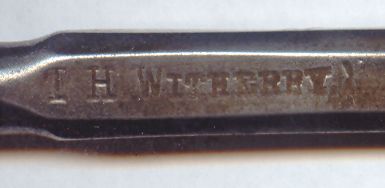

This next example, a 3/4 inch socket mortise chisel recently
uncovered by Sandy Moss,
is definitely from Millbury!
This is the only Millbury-era Witherby chisel I have seen that says "Warranted".

This marking is a little unclear, but my friend Chris Winter sent me a tracing from a chisel in his collection which shows more clearly what the stamp looked like. (Thanks Chris!)



Tony Seo keeps turning up some great old Witherby marks:
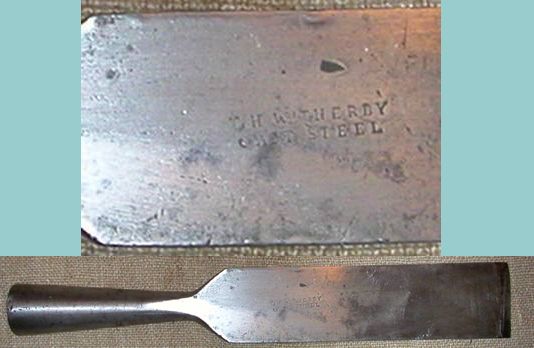
This one says T H Witherby in a diamond. It is on a narrow chisel,
so the whole diamond doesn't show.
My guess is that this is earlier, since the early examples have triangles or
arrows surrounding them, but I am not sure.


Here's another (better) example sent to me by Tony Seo:

This picture is here as a placeholder, until I can find a better example. Many Witherby gouges have this marking. The gouge on the cover of the paperback version of Mike Dunbar's Restoring, Tuning & Using Classic Woodworking Tools is a Witherby gouge with this same marking.
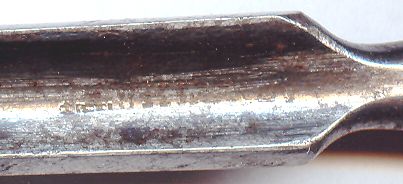
This is the most common Witherby stamp, with the word Warranted added, which, according to Trevor Robinson, means it was made by the Winsted Edge Tool Works.
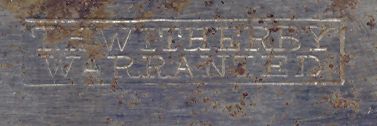
Even later models feature the above stamp on the top of the chisel and the following stamp on the back
WINSTED EDGE TOOL WORKS
--WINSTED, CONN. U.S.A.--

A recently acquired mortise chisel.
Most likely a Winsted-era chisel (since it says warranted)
It says
T.H. WITHERBY FRAMERS
SOLID STEEL WARRANTED
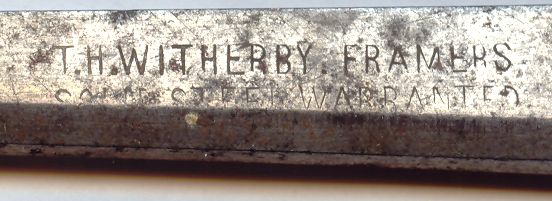

These are from the only two tanged Witherby chisels I own. Don't know if they are early or late.
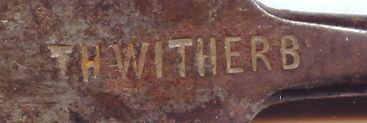
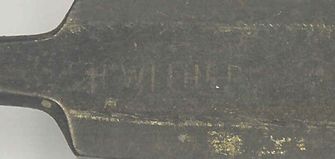

Here is a Winsted-era mark that Galoot Tony Seo sent to me (Thanks Tony!):

PLEASE SEND ME MORE EXAMPLES IF YOU HAVE THEM!
Witherby chisels are fairly common and highly sought after chisels. Below are just a few examples of the variety of chisels they made.
First up is a straight-sided firmer chisel, an 1/8th inch sash mortise chisel, and a lovely long thin paring chisel.
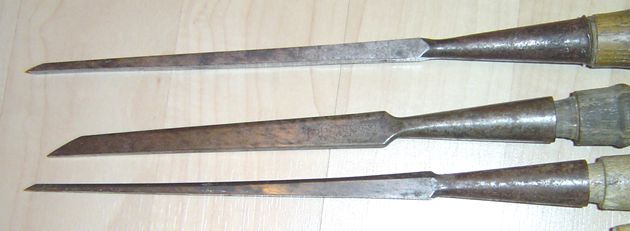
Next up is the first Witherby chisel I ever bought, a hefty
framing chisel.
This was long before I knew anything about chisels.
I thought it was English and I thought "cast steel" meant that the
steel was cast into the shape of a chisel!

Here is a Winsted-era Witherby skew chisels for turning.
These Witherby turning tools are not very common.

Below are three Witherby drawknives that Sandy
Moss recently had for sale on his website (Thanks Sandy!)
(BTW--Sandy always seems to have a nice variety of Witherby drawknives!)
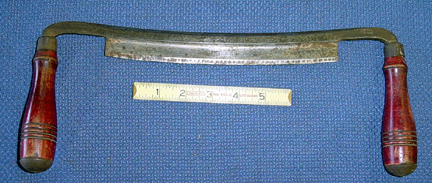
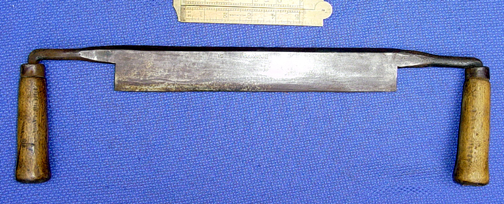
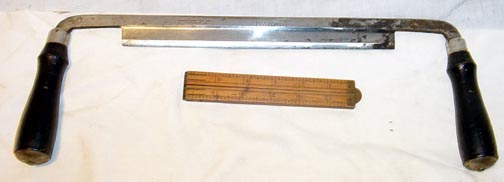
Thanks to all the Galoots out there, especially Trevor Robinson, Don McConnell, Sandy Moss, and Tony Seo who helped me with this research.
Copyright © 2008 by Brian Welch.
![]()